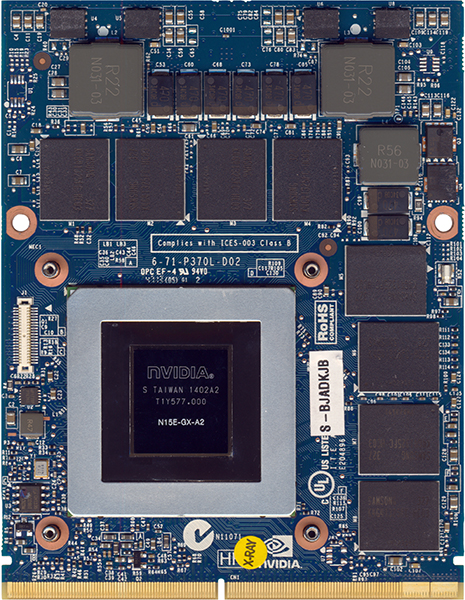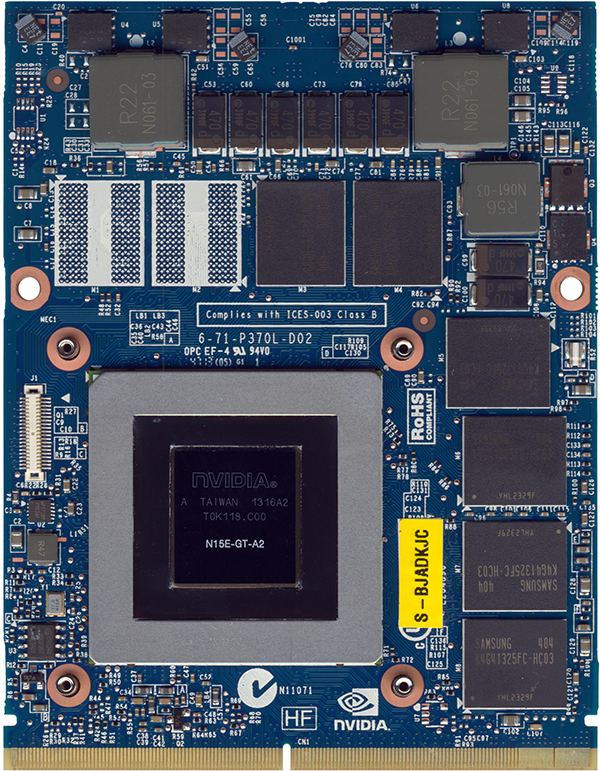GeForce GTX 880M, 870M, And 860M: Mobile GPUs, Tested
Nvidia is in the process of rolling out its GeForce GTX 800M-series graphics modules. Despite the new name, we're still looking at GK104-based GPUs. One thing is for sure, though: the processor is running faster than ever. We benchmark three models.
Introducing The GeForce GTX 800M-Series
Sometimes it feels like desktop gamers get all of the cool toys, while the notebook guys get hand-me-downs. Rare is it that a new graphics processor debuts in the mobile space. There's just so much more involved when you bring technology down into limiting form factors and power budgets.
It really comes as no surprise, then, that we're on a third generation of mobile products with Nvidia's GK104 in the mix. After all, that was quite the efficient GPU when it launched more than two years ago. Today it remains viable as the engine driving Nvidia's highest-end GeForce GTX 800-series modules. Let's take a look at some of the brand's specs:
| Nvidia GeForce GTX 880M Comparative Specs | |||||
|---|---|---|---|---|---|
| Row 0 - Cell 0 | Desktop GTX 780 | Notebook GTX 880M | Notebook GTX 780M | Notebook GTX 680MX | Desktop GTX 680 |
| Shaders | 2304 | 1536 | 1536 | 1536 | 1536 |
| Texture Units | 192 | 128 | 128 | 128 | 128 |
| Full Color ROPs | 48 | 32 | 32 | 32 | 32 |
| Graphics Clock MHz (Boost) | 863 (900) | 954 (993) | 771 (797) | 720 | 1006 (1058) |
| Texture Fillrate | 166 Gtex/s | 122.1 Gtex/s | 105.3 Gtex/s | 92.2 Gtex/s | 128.8 Gtex/s |
| Memory Clock | 1502 MHz | 1250 MHz | 1250 MHz | 1250 MHz | 1502 MHz |
| Memory Bus | 384-bit | 256-bit | 256-bit | 256-bit | 256-bit |
| Memory Bandwidth | 288 GB/s | 160 GB/s | 160 GB/s | 160 GB/s | 192 GB/s |
| Graphics RAM | 3 GB GDDR5 | 8 GB GDDR5 | 4 GB GDDR5 | 4 GB GDDR5 | 2 GB GDDR5 |
| Die Size | 551 mm² | 294 mm² | 294 mm² | 294 mm² | 294 mm² |
| Transistors (Billion) | 7.1 | 3.54 | 3.54 | 3.54 | 3.54 |
| Process Technology | 28 nm | 28 nm | 28 nm | 28 nm | 28 nm |
The original GeForce GTX 680M appeared to be an underclocked GeForce GTX 670; Nvidia quickly augmented performance through an updated GeForce GTX 680MX.
Here's the thing: you have a certain amount of freedom to ramp up clock rate and voltage on a graphics card designed for a desktop PC. Transitioning to a mobile form factor limits flexibility immensely. Sure, we've seen some huge desktop replacements with big graphics power inside. But both AMD and Nvidia are trying to enable technologies that make maximum performance available when it's needed, then scaling back as much as possible when it isn't.
Like the GeForce GTX 780M, Nvidia's recently-introduced 880M lifts all eight SMX units from the GK104 processor. Whereas the 780M operated at a 771 MHz base clock rate, however, the 880M starts at 954 MHz. Nvidia gives it a typical GPU Boost rating of 993 MHz. Both of those figures are far closer to the desktop GeForce GTX 680 (even if the new mobile flagship carries over the 780M's slower GDDR5-5000 data rate).
At least on the specification side, there's little more than this frequency increase to discuss. Memory density doubles, but without the large jump in GPU spec needed to push similarly-increased display resolutions. So, we have to hope that the latest GK104s coming out of TSMC are running faster at lower voltages to keep power and heat under control.
| Nvidia GeForce GTX 870M Comparative Specs | |||||
|---|---|---|---|---|---|
| Row 0 - Cell 0 | Desktop GTX 770 | Notebook GTX 870M | Notebook GTX 770M | Notebook GTX 670MX | Desktop GTX 670 |
| Shaders | 1536 | 1344 | 960 | 960 | 1344 |
| Texture Units | 128 | 112 | 80 | 80 | 112 |
| Full Color ROPs | 32 | 32 | 24 | 24 | 32 |
| Graphics Clock MHz (Boost) | 1046 (1085) | 941 (967) | 706 (797) | 600 | 915 (980) |
| Texture Fillrate | 134 Gtex/s | 105.4 Gtex/s | 64.9 Gtex/s | 48 Gtex/s | 102.5 Gtex/s |
| Memory Clock | 1753 MHz | 1250 MHz | 1002 MHz | 700 MHz | 1502 MHz |
| Memory Bus | 256-bit | 192-bit | 192-bit | 192-bit | 256-bit |
| Memory Bandwidth | 224 GB/s | 120 GB/s | 96 GB/s | 67.2 GB/s | 192 GB/s |
| Graphics RAM | 2 GB GDDR5 | 6 GB GDDR5 | 3 GB GDDR5 | 3 GB GDDR5 | 2 GB GDDR5 |
| Die Size | 294 mm² | 294 mm² | 221 mm² | 221 mm² | 294 mm² |
| Transistors (Billion) | 3.54 | 3.54 | 2.54 | 2.54 | 3.54 |
| Process Technology | 28 nm | 28 nm | 28 nm | 28 nm | 28 nm |
Moving down the stack, Nvidia's GeForce GTX 870M gives mobile users the same seven SMX units from the desktop GeForce GTX 670. The previous two generations (GeForce GTX 770M and 670MX) were both based on GPUs with five SMX blocks instead.
Get Tom's Hardware's best news and in-depth reviews, straight to your inbox.
The new GeForce GTX 860M offers an even bigger surprise, also utilizing the GK104 graphics processor. In this implementation, however, it includes six functional SMX units, yielding 1152 CUDA cores, similar to Nvidia's GeForce GTX 760 card. Of course, it operates at far lower base and typical GPU Boost frequencies, and is complemented by slower GDDR5-5000 memory on a narrower 128-bit bus. But that's all in the name of pulling power lower and making the 860M work in a line-up of other GK104-driven modules.
| Nvidia GeForce GTX 860M Comparative Specs | |||||
|---|---|---|---|---|---|
| Row 0 - Cell 0 | Desktop GTX 760 | Notebook GTX 860M | Notebook GTX 765M | Notebook GTX 660M | Desktop GTX 660 |
| Shaders | 1152 | 1152 | 768 | 384 | 960 |
| Texture Units | 96 | 96 | 64 | 32 | 80 |
| Full Color ROPs | 32 | 16 | 16 | 16 | 24 |
| Graphics Clock MHz (Boost) | 980 (1033) | 797 (915) | 797 (863) | 835 | 980 (1033) |
| Texture Fillrate | 94 Gtex/s | 76.5 Gtex/s | 54.4 Gtex/s | 26.7 Gtex/s | 78.4 Gtex/s |
| Memory Clock | 1502 MHz | 1250 MHz | 1002 MHz | 1250 MHz | 1502 MHz |
| Memory Bus | 256-bit | 128-bit | 128-bit | 128-bit | 192-bit |
| Memory Bandwidth | 192 GB/s | 80 GB/s | 64 Gb/s | 80 GB/s | 144.2 GB/s |
| Graphics RAM | 2 GB GDDR5 | 4 GB GDDR5 | 2 GB GDDR5 | 2 GB GDDR5 | 2 GB GDDR5 |
| Die Size | 294 mm² | 294 mm² | 221 mm² | 118 mm² | 221 mm² |
| Transistors (Billion) | 3.54 | 3.54 | 2.54 | 1.3 | 2.54 |
| Process Technology | 28 nm | 28 nm | 28 nm | 28 nm | 28 nm |
There's a caveat, though. Nvidia specifies its GeForce GTX 860M with two completely different GPUs. The same we received, of course, employs GK104. But you'll also find GeForce GTX 860Ms based on the GM107 found in the GeForce GTX 750 Ti. That’s kind of like reserving a 16-hand gelding for your day at the ranch and arriving to find a Shetland pony.
Of course, it's hard to say how both versions compare without having them both on-hand for testing. The GM107-based version is configured to run at similar clock rates as the card we tested in GeForce GTX 750 Ti Review: Maxwell Adds Performance Using Less Power, albeit with a slightly lower memory frequency. Meanwhile, GK104 is pared way back.
Without performance data to look at, we have to hope that Nvidia is realizing similar results from GK104 and GM107. If it's not, the most we can do right now is make you aware of the two different versions of GeForce GTX 860M.
Current page: Introducing The GeForce GTX 800M-Series
Next Page How We Test Nvidia's GeForce GTX 800M Graphics-
CaptainTom Eh these generations are all the same cards. Show us a 980M with full maxwell. Then we'll talk...Reply -
Puiucs we need them to finish working on 20nm fast. TSMC just can't do it anymore. global foundries has 14nm only on paper too....Reply -
guvnaguy I'm actually fairly impressed. Their website says a max of 6 hours battery on "UMA" mode. Would you be able to test this, Tom?Reply
Previously I wouldn't consider getting a gaming laptop due to their short battery life, even when not gaming. But if a laptop with this kind of hardware can manage 5 - 6 hours, I'd consider it... -
ubercake Page one gives the impression you might include desktop cards so we could get a frame of reference with regard to desktop v laptop GPU performance. Then I looked immediately at the BF4 page and found no desktop GPUs in the performance charts?Reply -
Ninjawithagun Highly disappointed overall by the 800M series performance. I can feel assured that my GTX780Ms in my Alienware 18 will serve me well for at least another year. So, whatever happened to multi-core GPUs?? The concept works well for desktop CPUs, yet we have not seen it in desktop or mobile GPUs as of yet? ATI's Hawaii GPU comes close in certain aspects regarding behavior like a multi-core GPU by handing off processes to other chips within the die. One step closer to a next-gen GPU, yet still so far...Reply -
jrharbort A shame this didn't include the Maxwell-based 860M. It performs much more in line with what we'd expect from a true next-gen mobile chip (I'm currently using said chip, and still exercising its capabilities). I can say it's roughly 30% faster than the previous gen 765M, and benchmarks by others have shown it to be twice as fast as the GTX 660M while staying at a max of 50W TDP. I've yet to do any real benchmarking myself, so if anyone cares to see any, leave me some suggestions of what to use (preferably free software).Reply -
hannibal Is there any way of knowing if you get kepler 860 or maxwell 860 when you buy a laptop?Reply
I hate these kind of naming tricks... Even 860a and 860b or anything that gives out what you will get.
-
jrharbort ReplyIs there any way of knowing if you get kepler 860 or maxwell 860 when you buy a laptop?
It is difficult to know unless you get more specific information from the manufacturer before purchase (or find benchmarks of the computer model you're looking at beforehand). The MSi GE60 Apache Pro was the first notebook to feature the Maxwell-based 860M.
I hate these kind of naming tricks... Even 860a and 860b or anything that gives out what you will get. -
dstarr3 ReplySo, whatever happened to multi-core GPUs?? The concept works well for desktop CPUs, yet we have not seen it in desktop or mobile GPUs as of yet?
GPUs have been multi-core for ages now. Well beyond desktop cores, even. The GTX880M in particular is a 1,536-core GPU. Similar numbers have been around for a long time.
http://www.geforce.com/hardware/notebook-gpus/geforce-gtx-880m/specifications



